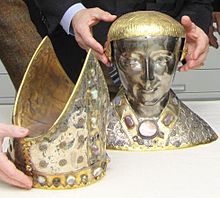Nusaybin is a border city in Southeastern Anatolia.
Understand
edit
Nusaybin is located at the foot of Mount Izla, which is part of Tur Abdin hills. The river Jaghjagh, known as Mygdonius in ancient times, runs through the city. Known as Nisibis, the city has been in existence since at least 901 BC, when it was part of the Assyrian Empire. In the Hellenistic period the settlement was re-founded and named "Antioch on the Mygdonius" by the Seleucid dynasty after the conquests of Alexander the Great. Later part of the Roman Empire and Sasanian Empire until conquered in 639 by the Rashidun Caliphate during the Muslim conquest of the Levant.
Jacob of Nisibis, the city's first known bishop and lauded as the "Moses of Mesopotamia", constructed its first cathedral between 313 and 320.
Get in
editGet around
editSee
edit
- 1 Church of Saint Jacob of Nisibis (Mor Yakup Kilisesi). 4th century Syriac Orthodox church.
- 2 Zeynel Abidin Mosque Complex (Zeynel Abidin Camii ve Külliyesi). Built in 1159, during Zengid dynasty. It consists of a mosque, a medrese and tombs of both Zeynel Abidin and his sister Sitti Zeynep, known as 13th-generation grand children of Muhammad.
- 3 (about 5 km north). This is a tell, or a mound with successive waves of settlement, which lasted from the 4th millenium BC to the Neo-Assyrian period. The local story is spookier: according to it, this is the abode of demons and anyone brave enough to spend a night here would shake off any malady.
- 4 Dara (31 km northwest, 7 km off D400 to Mardin, no signpost). This is the impressive ruins of a Byzantine fortress town founded against the Persians.
- 5 Monastery of St Augin (Mor Evgin Manastırı) (about 30 km northeast, off D400 to Cizre, signposted). A Syriac monastery on a majestically rugged mountainside. It was started in the 4th century by Saint Eugenios or Augin, an Egyptian monk who is traditionally believed to have introduced monasticism to Syriac Christianity. The monastery was abandoned in 1970, and reopened in 2011. The monks are sensitive about the clothing of the visitors, so cover up as much as you can.
Do
edit- 1 Mitanni Culture Centre (Kültür Mitanni Mer). Culture centre that hosts regular concerts and plays.
Buy
editEat
edit- 1 Beyazsu (Kurdish: Ava Spi) (on the road north to Midyat, about 20 km from Nusaybin). This is a popular picnic area along the valley of the river of the same name — a tributary of the Jaghjagh/Çağçağ. The lush greenery of the valley bottom is in a deep contrast with the arid landscapes surrounding it. There are restaurants with seating areas on stilts over the river.
Drink
editSleep
edit- 1 Kasr-ı Serçehan Hotel, Cumhuriyet Meydanı No:1, ☏ +90 482 415 47 47.
- 2 Avesis Hotel & Restaurant, İpekyolu Cd. No:45, ☏ +90 482 415 0525.
Connect
editGo next
edit- Mardin to the northwest is the province capital, with a great old city cascading down a hillside.
- The architecture in the old town of Midyat to the north is as impressive as that of Mardin, but it's on a flatter plateau without the views.
- Iraqi Kurdistan is a relatively safer part of Iraq, accessed by the Habur border post southeast of Cizre.
- Al-Qamishli is the twin town to the south across the border, but for a visit you'll have to hold your breath until the Syrian civil war is over.
| Routes through Nusaybin |
| Concurrent with |
W |
→ Cizre → Şırnak ( |
| Şanlıurfa ← Kızıltepe ( |
W |
→ Cizre → |

